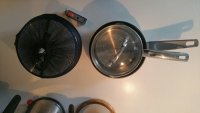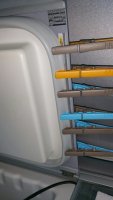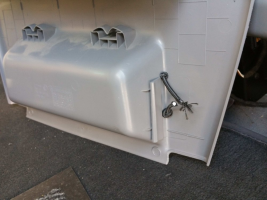M
marchugo
- Messages
- 498
Dutch cool box tuning to extend battery life

On this picture it's an optical illusion that the alu plate is skewed.
About eight years ago Peter, an engineer on the German forum Caliboard.de, invented this little aluminum helper. It encloses the temperature sensor on the right of the cool box and makes it think the temperature in the fridge is already low enough, so the compressor stops cooling.
This prevents that the fridge is cooling way too much, and ends the practice of freezing beer to ice deep in the box.
The 'miracle plate' deceives the sensor, and the effect is that this reduces the time the compressor is running. Normally the box is cooling for about 20 - 25 minutes per cycle, depending on ambient temperature and degree of loading. Now, with the plate (in a fully loaded box) the fridge is working about 15 minutes.
This not only saves energy (the fridge now uses about 1 to 2 Amps in stead of 3 Amps an hour). More important was another result way back then: the compressor didn't heat up the compartment under the fridge too much anymore. The heat there was accumulated by another source of warmth, the 230 V. Waeco battery charger, which at that time was situated in the same compartment. The Waeco cuts off above 59 Celsius, and thus stops loading the battery (and you don't notice it, untill you fish out your rotten vegetables).
Of course many Cali owners at the time all began folding their own pieces of aluminum like mad. There was a religious war of words about the question if this could work at all. The discussion ended when VW decided to move the Waeco charger to the battery compartment at the far end of the Cali. Also, the emerging solar panels made this aluminum miracle more or less obsolete.
Still, the fridges in our Cali's are of a sub optimal technique. They cool too much at the bottom and the back, and not enough at the front and top sections. And they really are isolated very bad. By optimizing the box with this alu plate, and perhaps a fan under and in the box, it is possible to gain slightly better cooling effects.
In my van a fully loaded fridge now takes almost 12,5 minutes to cool down from 10,2 Celsius to 7,2 C., at an ambient temperature inside the bus of 22 degrees and a summer sun on the fridge side. Then the compressor is silent for about 45 minutes, as I noted whith a simple thermometer in the middle of the vegetable basket, while reading a book and enjoying a fine glass of wine. Every time the compressor stopped, we poured another glass of Rioja, which might have influenced this scientific experiment.
It's very simple to fold this alu plate. It takes a leftover of 2 MM aluminum plate, a Black & Decker Workmate and some strong hands. The plate of about 10 CM height stretches to half way the back side (there is the cooling element). The alu plate brings the cold from the backside to the sensor, faster then the stationary air in the fridge could do that.
The small "house" around the sensor is closed at the top, but open at the bottom, to release possible water drops. It sticks to the wall with a non aggressive glue. First degrease the wall with alcohol.
But of course it all remains a matter of belief... (I'm a believer, but it might be the Rioja).
Regards from Amsterdam,
Marc.

On this picture it's an optical illusion that the alu plate is skewed.
About eight years ago Peter, an engineer on the German forum Caliboard.de, invented this little aluminum helper. It encloses the temperature sensor on the right of the cool box and makes it think the temperature in the fridge is already low enough, so the compressor stops cooling.
This prevents that the fridge is cooling way too much, and ends the practice of freezing beer to ice deep in the box.
The 'miracle plate' deceives the sensor, and the effect is that this reduces the time the compressor is running. Normally the box is cooling for about 20 - 25 minutes per cycle, depending on ambient temperature and degree of loading. Now, with the plate (in a fully loaded box) the fridge is working about 15 minutes.
This not only saves energy (the fridge now uses about 1 to 2 Amps in stead of 3 Amps an hour). More important was another result way back then: the compressor didn't heat up the compartment under the fridge too much anymore. The heat there was accumulated by another source of warmth, the 230 V. Waeco battery charger, which at that time was situated in the same compartment. The Waeco cuts off above 59 Celsius, and thus stops loading the battery (and you don't notice it, untill you fish out your rotten vegetables).
Of course many Cali owners at the time all began folding their own pieces of aluminum like mad. There was a religious war of words about the question if this could work at all. The discussion ended when VW decided to move the Waeco charger to the battery compartment at the far end of the Cali. Also, the emerging solar panels made this aluminum miracle more or less obsolete.
Still, the fridges in our Cali's are of a sub optimal technique. They cool too much at the bottom and the back, and not enough at the front and top sections. And they really are isolated very bad. By optimizing the box with this alu plate, and perhaps a fan under and in the box, it is possible to gain slightly better cooling effects.
In my van a fully loaded fridge now takes almost 12,5 minutes to cool down from 10,2 Celsius to 7,2 C., at an ambient temperature inside the bus of 22 degrees and a summer sun on the fridge side. Then the compressor is silent for about 45 minutes, as I noted whith a simple thermometer in the middle of the vegetable basket, while reading a book and enjoying a fine glass of wine. Every time the compressor stopped, we poured another glass of Rioja, which might have influenced this scientific experiment.
It's very simple to fold this alu plate. It takes a leftover of 2 MM aluminum plate, a Black & Decker Workmate and some strong hands. The plate of about 10 CM height stretches to half way the back side (there is the cooling element). The alu plate brings the cold from the backside to the sensor, faster then the stationary air in the fridge could do that.
The small "house" around the sensor is closed at the top, but open at the bottom, to release possible water drops. It sticks to the wall with a non aggressive glue. First degrease the wall with alcohol.
But of course it all remains a matter of belief... (I'm a believer, but it might be the Rioja).
Regards from Amsterdam,
Marc.


















































